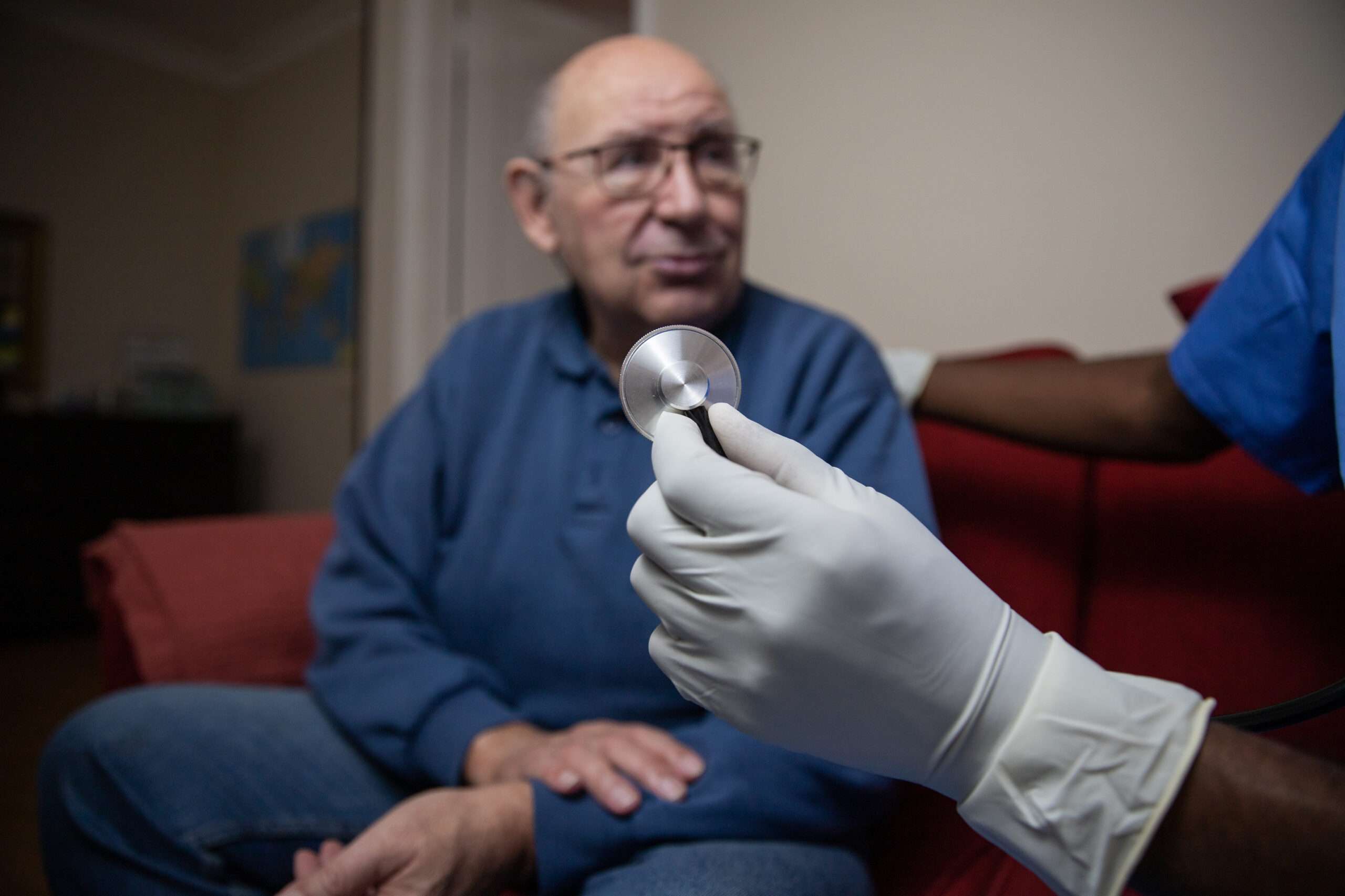Welcome to Beyond the Hospital: Voices in Advanced Care at Home, an interview series hosted by Chi-Cheng Huang, MD, Chief Medical Officer, and David Zimmerman, Chief Operating Officer at Inbound Health. Each episode features top voices in home-based healthcare who share the latest trends, innovations, and personal stories shaping the future of care delivery.
In this episode, we welcome Krista Drobac, Partner at Sirona Strategies, Executive Director of Moving Health Home, and a longtime policy leader and advocate for care in the home. Drawing on her decades of experience shaping federal healthcare policy, Krista discusses the challenges and triumphs surrounding the push for hospital-at-home and highlights how coalitions, health systems, and industry partners each play a critical role in driving change for the future of care delivery.
Dave Zimmerman: To kick us off, I’d love to hear about your background. What motivates you to stay in the public policy space?
Krista Drobac: It’s gotten a lot harder to get things done, but I still feel like we can. This is my 30th year in Washington. I came right after college, because you can accomplish a lot here. I worked on Capitol Hill, I worked at the Centers for Medicare & Medicaid Services (CMS), I led the Health Division for the National Governors Association––all to try and change a little piece of the world. While there’s a lot going on in the news, there are still people on the ground doing good things.
DZ: Throughout your time on the Hill, how have things changed in terms of what it takes to get policy enacted?
KD: When it started, it was all about making deals. Now, you have to have a coalition. As I tell people, you need to find your fellow travelers and go in as a group. It’s hard for one company or one organization to change things; that’s why we reach out to patient groups, provider groups, and business groups across the spectrum, so we go in together to say, “This impacts all of us and we need a change.” It really does take a village nowadays. It also takes more evidence. People want to know: Will this policy work? Is it going to raise costs? How will it impact patients? It’s less about knowing the right people, and more about having the story and the people around you to make an impact.
DZ: Is that part of the origin behind Moving Health Home?
KD: I’ve always been a big believer in coalitions. I started out in telemedicine. And if you think about it, one company isn’t going to be able to do the lift that’s necessary to, for instance, permit telemedicine and Medicare in perpetuity. We launched the Alliance for Connected Care in 2013 with the goal of securing coverage for telehealth services in Medicare. In 2020, we felt like it was finally going to happen. We’d already worked with the first Trump administration to remove the statutory barrier for remote monitoring, and we felt like telehealth was next. But then we thought, well, what happens if we get telehealth and remote monitoring? It still doesn’t create an in-home benefit. All you’re doing is paying for the tools––you’re not creating the care model.
So, we started Moving Health Home to extend hospital-at-home and raise awareness around all the things that can be done if we change the care models. For instance, how can we ensure that we don’t need a nurse in the home 24/7 for an SNF-at-home benefit? Patients and caregivers want to be home. There’s better care, more resilience, better mental health, no hospital-acquired infections––so many good things. I hope care-at-home becomes the future.
DZ: I’m biased, but I couldn’t agree more. What’s the temperature in Washington around home-based care?
KD: It’s always part of the conversation. The challenge is creating the right policy window. There are always a few major issues dominating the healthcare landscape, and it takes a significant amount of effort to break through the noise. But we’ve got a real crisis underway, and it takes groups like ours to keep pushing for attention, action, and solutions.
I do think it’s possible—we just need to seize every opening. For example, the $50 billion Rural Health Transformation Fund passed by Congress in the One Big Beautiful Bill (OBBB) mentioned care-at-home, as did the Physician Technical Advisory Committee to CMS. Any time Congress or a committee recognizes home-based care, we have to jump on it, amplify it, and make sure it’s heard. That’s how we build momentum and get people excited about this work.
DZ: Compared to the Biden administration, how have you seen interest in this space change under the second Trump administration?
KD: The difference has been striking. The team he has at CMS is deeply interested in tech-enabled care—things like remote monitoring, wearables, and tools that can measure blood pressure and other critical health indicators. They recognize the capacity challenges we’re facing with an aging population, so in that sense, we’re in a better position, but at the same time, we’re worse off with a secretary whose main focus is wellness and prevention. He talks a lot about chronic disease, which is important, but our emphasis is more on tertiary care, not prevention.
DZ: A lot of people are eager to see what happens with the extension of the hospital-at-home bill. Where do things stand now, and how do you expect to see this play out over the next few months?
KD: The challenge is that hospital-at-home is tied up with the year-end funding package, which has become the norm. Thirty years ago, we’d pass standalone bills—and something like this, which doesn’t cost money, could go through unanimous consent and pass without a vote. Today, almost everything is subject to a vote, and bills are often bundled into larger packages. Lawmakers use larger vehicles, such as the debt ceiling or year-end funding, to attach priorities and secure votes, which makes it harder to move something like hospital-at-home on its own.
That said, we’re in a strong position. Last year, despite the chaos, we still managed to secure a spot in the second funding bill, even if only for a short-term extension. And we’ve gained a new set of champions in Congress, which is a real testament to the advocacy in this space. We now have a five-year extension bill with broad support, and over 120 organizations have signed onto a letter urging Congress to act. Since it doesn’t cost anything, we have a good score and strong champions. It’s possible Senate leadership will decide to resolve this with a full five-year extension, just to get it off the table. Or they could tie it to the same timeline as telehealth, which faces a similar situation. Either way, we’re confident there will be an extension—it’s just a matter of how long.
DZ: Tell us about the work you’re leading around SNF-at-home.
KD: Hospital-at-home really paved the way for showing what care in the home can do, and SNF-at-home is the natural next step. Right now, we have a hospital discharge crisis—patients are stuck in ERs because they can’t get a hospital bed, and those beds are tied up because people can’t get into a SNF. It’s exactly the kind of bottleneck you see dramatized on shows like “The Pitt”.
SNF-at-home helps relieve that capacity problem. There are so many good things about sending someone home. Patients and caregivers really want it, providers get to see the home environment, people can rehab in their own home and get back into their own routines—it’s a win all around. [H2] The barriers are statutory: the law requires 24/7 on-site nursing and physical infrastructure, the same two requirements we waived for hospital-at-home. What we’re advocating for is a five-year demonstration project that would enable patients to return home while we collect robust data on length of stay, readmissions, infections, and outcomes.
And because it’s a statutory barrier, we need the legislation. Republicans are very supportive, and some Democrats are too, but others question whether we need another post-acute option instead of fixing SNFs or home health. That’s the hurdle. But once there’s broader bipartisan agreement, I think this will move forward. Everyone recognizes the capacity crisis we’re facing; we just need to get more decision-makers on board.
DZ: Beyond that issue of alignment, what other barriers could potentially get in the way of launching this kind of demonstration project?
KD: There’s always some opposition. I don’t think the SNF industry will love this—though some will, especially those that also own home health agencies, since they’d be well positioned to provide a SNF-at-home benefit. So, the industry may be somewhat divided. Whenever you introduce a new model, certain groups will feel that it disrupts their position, while others see it as an opportunity. The key is building a coalition big enough to withstand opposition from other industry groups.
DZ: What guidance or hope do you have for these coalitions given the landscape? What key role should they be playing at this point in the process?
KD: The Alliance for Connected Care has already had some big wins. In 2018, we successfully convinced CMS Administrator Seema Verma to unbundle the CCM codes from the remote monitoring code. That created two separate payments and marked the first time remote monitoring was reimbursed. After that, the AMA created three new codes that are also paid for—another huge win.
More recently, in the OBBB, the Alliance secured permanent coverage for telehealth within the deductible for people on high-deductible health plans and HSAs. That means employers can now offer discounted or even free telehealth before a deductible is met, and that was a really big win. Looking ahead, the key wins for Moving Health Home would be five-year demonstrations for both hospital-at-home and SNF-at-home, and ultimately, a bundled payment for primary care delivered in the home. To get there, coalitions need to keep raising the profile of care in the home, proving the use cases, gathering data, expanding the tent, and keeping up a steady drumbeat of advocacy.
DZ: How can health systems, provider groups, and third parties like Inbound Health play a key role in shaping that voice and moving the industry forward?
KD: The biggest thing is to make time to get involved. Whether that’s joining a coalition, talking to your member of Congress, or reaching out to folks like me, even something small can make a difference. One reason groups like ours exist is that hospital systems are often consumed with big-ticket issues that carry major financial implications. Their government affairs teams don’t always have the bandwidth to dig into more niche issues like care-at-home or telehealth. That’s why systems like Intermountain, Ascension, MedStar, and Johns Hopkins join our groups; they know these are critical priorities that may not get the same level of attention elsewhere.
So, my advice is to talk to your government affairs teams and let them know this matters. Even if it’s not the issue that will cost your hospital millions, it’s important for the future of care delivery. Ask them to get involved. The only way we’re going to get this done is if we have a lot of people at the table.
DZ: After 30 years in the space, what keeps you motivated in the fight to advance policy?
KD: I’m a policy nerd. I get jazzed when I see models that work. And there are people on Capitol Hill and in the administration who respond to research, data, and real-world results, and are interested in trying what’s working. That keeps me motivated.
I don’t necessarily expect sweeping reform of the entire system anytime soon, but if we can launch pilots based on proven approaches, and then gradually expand and scale them, real change will follow. Over time, people will start asking, “Why isn’t everyone in an ACO? Why aren’t we all in risk-sharing arrangements?” That’s how progress works; you just have to chip away at it.
My hope is to lay the groundwork now so the next generation can finish the job.
-
Beyond the Hospital: Krista Drobac, Partner at Sirona Strategies and Executive Director of Moving Health Home

-
Optimizing Value in the Care Continuum: A Real-World Claims Analysis

As the healthcare industry faces increasing regulatory changes, margin pressures, and rising costs, companies like CVS Health and Humana are feeling the squeeze. Experts emphasize the need for value optimization, with low-cost care settings showing the most potential for success. Inbound Health and Allina Health are leading the way with their innovative Elevated Care at Home (ECH) program. Developed in response to the COVID-19 pandemic, ECH offers an alternative to traditional hospital stays and post-acute care services, improving outcomes while addressing capacity and cost challenges. Together, Inbound Health and Allina Health are transforming transitional care to enhance both quality and affordability.
-
Improving Patient Outcomes with Acute Hospital Care at Home

Preliminary Analysis of Hospital Care at Home Performance Outcomes
This preliminary analysis examines performance outcomes in patients discharged to Inbound Health’s Hospital Care at Home program, which meets CMS Acute Hospital Care at Home requirements, within a Minneapolis-based health system.
Patients in Inbound’s program had a lower 30 day readmission rate compared to matched patients based on severity of illness. Also, the mean length of inpatient stay was shorter with the Inbound Health cohort of patients.
We improved care and created greater efficiency for our patients, families, and healthcare systems.
-
Maximize the 90 Day Acute Hospital Care at Home Extension

The 90-day extension of the Acute Hospital Care at Home (AHCAH) waiver provides hospitals with continued flexibility from the Centers for Medicare and Medicaid Services (CMS), allowing them to deliver certain types of acute care in patients’ homes rather than requiring admission to a traditional inpatient facility.
Originally introduced during the COVID-19 public health emergency (PHE), the AHCAH waiver was designed to help hospitals manage patient surges more effectively, utilizing telehealth and home-based care solutions. Under the waiver, hospitals can treat eligible patients at home with appropriate medical oversight, including remote monitoring and necessary therapeutic interventions, thereby extending hospital-level care beyond the traditional setting.
Key Implications of the 90-Day Extension for Health Systems
Continued Flexibility for Hospitals:
The 90-day extension provides health systems with additional time to integrate home-based care into their operational strategies. This enables hospitals to treat patients who require acute care but do not need full hospitalization, optimizing the use of hospital resources.
The extension also offers hospitals greater flexibility in managing patient volume and capacity, helping to prevent strain on physical facilities—particularly in the face of potential patient surges.
Financial Impact:
Reimbursement and funding: The waiver enables hospitals to receive reimbursement for acute care provided at home, as though the care were delivered in an inpatient setting. These reimbursement rates may be subject to adjustment or extension as policies evolve.
Hospitals can continue billing Medicare for home-based acute care services, which represents a critical revenue stream. If this flexibility is extended or made permanent beyond the 90-day period, it could offer significant financial relief, particularly for hospitals in rural or underserved areas facing resource constraints.
Operational Adjustments:
Health systems may need to invest in infrastructure like telehealth systems, remote patient monitoring technologies, and home health nurse services to comply with the AHCAH requirements.
For hospitals not already equipped for home-based acute care, the extension provides an opportunity to ramp up resources or partner with home health solution providers.
Patient-Centered Care:
The extension allows hospitals to continue to offer patient-centered care by providing more comfortable care options for patients who are appropriate for home care, reducing the risk of hospital-acquired infections and improving patient satisfaction.
Quality of Care and Regulatory Compliance:
Hospitals will need to continue ensuring that the care provided at home meets the necessary clinical standards. Compliance with all applicable regulations and quality of care measures will be crucial to maintain eligibility for reimbursement.
Monitoring and quality assurance processes will remain key, as patients receiving care at home will still require oversight by healthcare providers to ensure their safety and well-being.
Strategic Planning:
Health systems might use the 90-day extension to evaluate the feasibility of incorporating hospital-at-home models into their long-term strategies. For some systems, the waiver could help them test these models on a larger scale to understand the financial, operational, and clinical implications before committing to more permanent changes.
Next Steps
The 90-day extension of the AHCAH waiver provides health systems with a unique opportunity to expand and refine their home-based care services. Inbound Health can be a key partner in this process by offering a comprehensive, scalable solution for delivering acute hospital-level care at home, ensuring regulatory compliance, improving patient outcomes, and optimizing operational efficiency. Our expertise in hospital-at-home care helps health systems confidently navigate this new care model and maximize the benefits of the waiver extension.
Discover what healthcare systems can do during this 90-day period, key insights from Washington officials and staff, and how Inbound Health can support your health system.
Read and download the details below.
-
How CMS and Private Payers Are Adapting to Hospital Care at Home

Hospital-Care-at-Home (HCAH) saw federal implementation in response to the COVID-19 pandemic and has since gained significant momentum in large part because of the numerous benefits seen by healthcare facilities, professionals, and patients alike.
In recent years, an increasing emphasis has been placed on cost-effective healthcare that is also patient-centric, lowering care costs while maintaining (or even improving) the quality of care given and the outcomes received. As technology continues to advance, telemedicine has also seen greater implementation, leading to a greater capacity for providing hospital-quality care at home.
Both the Centers for Medicare & Medicaid Services (CMS) and private payers have adapted to the evolving healthcare landscape and growing demand for home-based care, whether it’s to improve care, lower costs, or make healthcare more efficient, lowering the backlog of cases that drive down hospital care quality.
CMS: The Catalyst of Federal Hospital-At-Home Initiatives
In November 2020, in response to the COVID-19 pandemic, CMS launched the Acute Hospital Care at Home (AHCAH) initiative, which allows certain hospitals that are Medicare-certified to treat their patients at home with care that resembles inpatient-level quality. With this initiative, CMS made it possible for Medicare patients to receive care at home when they meet certain criteria, opening up hospital beds for those who need inpatient care.
One way in which CMS has adapted to hospital care at home is through the establishment of the AHCAH waiver, which has some key changes to Medicare rules, such as:
Location flexibility – Hospitals may provide acute inpatient services in a patient’s home rather than a traditional inpatient setting.
Eligibility criteria – There are specific criteria that patients must meet in order to be eligible for HCAH, including their home environment (it must be safe and stable), clinical needs, and logistical support. The purpose of CMS’s criteria is to ensure that patients who are recommended for HCAH have the greatest likelihood of seeing its benefits, similar to how certain drugs are only FDA-approved for specific patient populations.
Telemedicine integration – Through the waiver, CMS allows for remote monitoring, telemedicine, and other digital health tools to be used in order to constantly survey patients and communicate with their care teams.
Through these adaptations in CMS rules, hospitals that offer HCAH remain eligible for Medicare reimbursement.
The HCAH initiative saw such great success that in 2023, through the Consolidated Appropriations Act, the waivers and flexibilities outlined above were extended through the end of 2024. Congress is expected to vote on whether to extend the HCAH initiative beyond 2024 in the next few days. Not only does this continue to allow hospitals to offer care at home for their patients, but it also shows CMS’s commitment to integrating hospital care at home into the broader healthcare system. It also allows hospitals to apply for hospital care at home on an ongoing basis rather than only in emergencies.
Finally, CMS has adjusted its payment structure in order to continue supporting hospital care at home. Through their new payment structure, hospitals are reimbursed similarly to traditional inpatient stays.
For HCAH services, CMS uses a bundled payment model wherein hospitals receive a single payment for the entire episode of care, which covers all services that are delivered to the patient at home based on the reimbursement amount for in-person care. The payment model also adjusts for the level of care required and the duration of the home care episode, which is designed to align financial incentives with cost efficiency and improved patient outcomes.
The CMS AHCAH program shifted home care from an experimental hope to a strategic priority, and their adaptations have made it possible for hospitals across the country to initiate and expand their hospital-at-home programs.
How Private Payers Are Joining In
Private payers often align their adjustments with the Centers for Medicare and Medicaid Services, typically by implementing policy changes that gradually resemble CMS’s policies.
As more and more providers see the benefits of hospital care at home, there is a shift toward greater funding and implementation. Some payers have goals to move more of their medical patients to home care, with research continually pointing out care services that can see the shift to at-home care.
In the past, many private payers did not pay for care at home or telemedicine services, both key elements of hospital care at home. However, payers are accepting the shift of the healthcare market and expanding their coverage to these key areas, making hospital care at home possible.
When it comes to private payers, one of the greatest challenges in implementing a program of this scale and investing in it properly is ensuring that there will be enough of a need to make the investment worthwhile. Payers are adapting to this challenge by using greater sources of data to drive their advancements. Specifically, data allows payers to understand the patient population of their network or hospital and determine if enough patients with conditions that may be treated at home are admitted. Furthermore, this data allows payers to find an in-demand need to focus on first, helping them to prioritize the new technologies, processes, and additional specialized personnel that are needed to offer treatment for one specific service line at home.
The upfront cost of implementing hospital care at home remains a challenge for private payers, but to further mitigate the financial risks, some health systems may choose to partner with third parties. Some healthcare firms are building hospital-at-home programs as standalone services that are then marketed to hospitals, physicians, and insurers. For institutions that do not have the means to implement their own program, the third-party option is an adaptation that makes hospital care at home possible for their patients.
Thanks to the implementation and benefits analysis of the AHCAH initiative completed by CMS, private payers are able to see how they can also benefit from embracing hospital-at-home, prompting them to jump on the bandwagon. Challenges still exist for many payers, but they are learning to adapt in order to implement healthcare’s most promising care innovation.
Adapting to Hospital Care at Home
The beauty of the healthcare field is that it is eternally evolving—yesterday’s challenges soon become obsolete thanks to tomorrow’s advancements. However, the key to making the most of these advancements is for healthcare facilities and institutions to evolve and adapt, as well, which CMS and private payers are actively working on with hospital care at home.
Hospital-at-Home is one of the most evidence-based healthcare delivery innovations of the past few decades, which is why we are seeing so many adaptations to make the most of this advancement. With each step forward, hospitals improve their care quality, and health systems lower the cost needed to provide exceptional care.
For those looking to jump on board, Inbound Health helps providers build and operate hospital-at-home programs and helps payers develop payment models with health systems. If you’re unsure how to adapt to HCAH, Inbound Health can help.
References
Acute Hospital Care at Home Data Release Fact Sheet | CMS. (2024). Cms.gov. https://www.cms.gov/newsroom/fact-sheets/acute-hospital-care-home-data-release-fact-sheet
-
Hospital-at-Home Saves Both Lives and Money, but Congress Must Act to Keep It Alive

When it comes to ongoing healthcare initiatives aimed at improving care outcomes, the Acute Hospital Care at Home (AHCAH) program exceeds expectations by also increasing patient comfort, lessening the burden on hospitals, and lowering spending.
While the AHCAH program was launched by the Centers for Medicare and Medicaid Services (CMS) in response to the COVID-19 pandemic and its overwhelm of hospitals, the improved outcomes and lower spending seen with the program have lasted even after the pandemic ended. Offering in-patient level care at home allows hospitals to care for more patients, decreases a backlog of filled beds, and lessens the need for unnecessary procedures and treatments resulting from delayed care. The AHCAH program has shown the benefits it offers to the healthcare system, but it will nevertheless expire if Congress does not act by the end of the year.
Extending the AHCAH Program
The AHCAH program has already been extended once; it was initially planned to last only through the pandemic’s emergency period, but the Consolidated Appropriations Act of 2023 extended AHCAH through December 31st, 2024. Since the time of its expiration has arrived, Congress must once again act to keep in action this initiative that improves outcomes while also lowering healthcare costs, a win for patients and carers alike.
While the deadline is quickly approaching, its renewal is not entirely out of the question. The Telehealth Modernization Act of 2024, which has bipartisan support in the House and Senate, includes an extension of the AHCAH waiver through 2029 that is supported by the American Medical Association. The hospital-at-home waiver offers hospitals reimbursement for providing at-home care to their patients with Medicare and Medicaid. The waiver also removes the requirement that a nurse must be present 24/7.
The Impact of AHCAH’s Expiration or Extension
The AHCAH program is no small feat and has become a cornerstone of Medicare programs. There are over 350 approved hospitals across more than 130 health systems that implement this innovative form of care delivery, and the expiration of the AHCAH program could be detrimental to these systems that rely on providing care-at-home services.
All patients can benefit from AHCAH. Rather than overcrowd hospitals, sometimes to the point where patients receive emergency care in hallways because no rooms are available, patients can be moved to their homes to complete the remainder of their care. For the aging population, care at home offers the opportunity for them to age in place, something that three-quarters of those in the United States over the age of 50 desire.
Knowing the universal benefits of the AHCAH, the expiration of this model can hurt all patients, but especially those with dementia, social barriers, and physical/sensory disabilities—for these individuals, care at home can make all the difference in their comfort, adherence to treatment, and treatment success.
AHCAH also offers healthcare workers a glimpse into the lives of their patients, which offers greater insights that can further improve the care they’re capable of providing.
Additionally, care-at-home programs demonstrate their superiority when it comes to lowering spending while improving healthcare outcomes. A report by CMS found that the mortality rate for AHCAH was lower for all 25 Medicare Severity Diagnostic Related Groups (MS-DRGs) they analyzed and significantly lower for 11 of these 25 MS-DRGs. Spending is lower, as well, with care-at-home shown to have lower Medicare spending in the 30 days after treatment for more than half of the top 25 MS-DRGs.
An extension of the AHCAH initiative gives health systems time to implement a care-at-home program or continue improving and expanding those that are already in place. It allows these facilities to provide for patients who can and want to be treated at home, increasing the care capacity of hospitals without increasing the costs required to provide this care.
How Inbound Health Can Help
If the AHCAH program is extended, it will provide your healthcare system with a vital opportunity to bring the benefits of care-at-home to your patient population, and Inbound Health can help.
Inbound Health partners with health systems to build, launch, and operate acute and post-acute care at home programs, allowing you to take the guesswork out of the best way to bring to life a successful AHCAH program that improves outcomes and lowers spending.
When it comes to the AHCAH program, the ball may currently be in Congress’s court, but you don’t have to wait to learn more about how Inbound Health helps health systems.
References
Fact Sheet: Report on the Study of the Acute Hospital Care at Home Initiative | CMS. (2024, November). Cms.gov. https://www.cms.gov/newsroom/fact-sheets/fact-sheet-report-study-acute-hospital-care-home-initiative
H.R.7623 – 118th Congress (2023-2024): Telehealth Modernization Act of 2024. Congress.gov. https://www.congress.gov/bill/118th-congress/house-bill/7623
Hospital at home saves lives and money: CMS report. (2024). American Medical Association; https://www.ama-assn.org/delivering-care/population-care/hospital-home-saves-lives-and-money-cms-report
Davis, M. R. (2022). 77 Percent of Older Adults Want to Remain in Their Homes as They Age. AARP. https://doi.org/1062105/3752820195
-
The Results Are In: CMS’s Report on the Acute Hospital at Home Initiative

The Acute Hospital Care at Home (AHCAH) initiative was launched during the COVID-19 public health emergency to address rising waiting times in hospitals, improve the quality of care received by patients, and protect essential workers. The Consolidated Appropriations Act, 2023 (CAA, 2023) extended the waivers and flexibilities of the AHCAH until the end of 2024 with the requirement that the Centers for Medicare & Medicaid Services (CMS) conduct a study and analysis on the AHCAH initiative. On September 30th, 2024, CMS released the findings of this study comparing AHCAH with brick-and-mortar hospital inpatient programs; detailed below are the highlights of their findings.
Quality of Care
Beginning with quality of care, the CMS study found that mortality rate was lower for those receiving care under the AHCAH initiative compared to those who were treated for the same conditions in brick-and-mortar inpatient facilities. Additionally, hospital-acquired conditions (HACs) were less common in hospital at home individuals for all six types of HACs evaluated.
As for readmissions, AHCAH was slightly superior to brick-and-mortar facilities, with AHCAH having a significantly higher rate of readmissions for two MS-DRGs while inpatient facilities have a significantly higher rate for three MS-DRGs.
Costs
To compare the cost of utilization, the study focused on metrics such as length of stay per episode and Medicare spending within 30 days of hospital discharge. The study found that AHCAH inpatients had a length of stay that was slightly longer, but the average amount of Medicare spending in the 30 days following treatment was lower for each care episode.
Of note, the differences in patient selection criteria and clinical complexity prevent CMS from stating, with certainty, that AHCAH resulted in lower Medicare spending compared to inpatient care at a brick-and-mortar facility.
Of note, the differences in patient selection criteria and clinical complexity prevent CMS from stating, with certainty, that AHCAH resulted in lower Medicare spending compared to inpatient care at a brick-and-mortar facility.
Patient Experience
Through virtual listening sessions and anecdotal information, the study concluded that patients and caregivers alike had a positive experience with the care provided through the AHCAH initiative. Clinicians, as well, mirrored this positive feedback in regard to their ability to provide care services.
Future Considerations
CMS’s study highlights the need for more targeted measures of quality, cost, and utilization in order to better understand how AHCAH compares to brick-and-mortar inpatient care. However, the continuation of the AHCAH initiative beyond December 31st, 2024—when the CAA, 2023 expires—is contingent on Congressional action.
There are currently several bills in Congress that would extend the CMS waiver between 2 to 5 years. With the CMS study complete and its favorable results for the AHCAH released, we await news regarding the extension of the CMS waiver.
If you’re intrigued by the findings of the CMS study, learn how Inbound Health enables healthcare systems to launch, operate, and scale acute and post-acute care programs.
Reference
Fact Sheet: Report on the Study of the Acute Hospital Care at Home Initiative | CMS. (2024). Cms.gov. https://www.cms.gov/newsroom/fact-sheets/fact-sheet-report-study-acute-hospital-care-home-initiative
